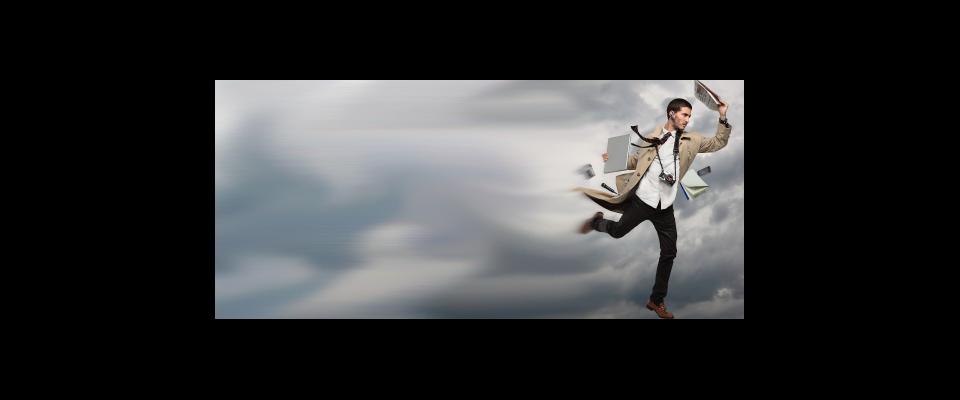The keynote speaker at the 2014 commencement of the UC Berkeley Graduate School of Journalism—an elite institution that prepares students for a profession in which the prospects are, let’s face it, a little touch-and-go at the moment— was a former small-time drug dealer and heavy-duty coke addict who had been in and out of rehab five times, a “fat thug” (in his own words) who’d been known to beat women and wave a gun around on occasion.
That speaker was David Carr. A beloved media critic at The New York Times, Carr had gone clean and climbed the ranks of his profession while also raising his twin daughters as a single dad. All of which made him a sort of prodigal son and, in many ways, a prime specimen of the increasingly rare genus, Journalist—that semirespectable race of outsiders who, if they are lucky, still populate newsrooms and wear press passes, but who more and more commonly get by on their own, the shingle outside their door reading “Freelance.” And those too are the lucky ones. The more desperate have had to cross over to what many die-hard journalists still call the Dark Side—i.e., public relations and advertising.
It’s so bad that a recent jobs survey ranked newspaper reporter the worst job in America, after lumberjack and line cook.
Of course, journalism is hardly the first or only business to have been upended by the digital revolution, which in hindsight it’s clear we should have seen coming. Alvin Toffler certainly did. Way back in antediluvian 1980, the futurologist described what he called the Third Wave (the First Wave being the rise of agriculture; the Second, the Industrial Revolution), in which the media would be “de-massified,” a new “info-sphere emerging alongside the new techno-sphere.” The new media, Toffler presaged, would “not feed us fully formed chunks, but broken chips and blips of imagery.” You know, like tweets.
Tech entrepreneurs tend to wax giddy about the changes wrought by this tidal surge. Disruption, they call it, or creative destruction. Or disintermediation, whatever that is. But the way we buy shoes or hail a cab is one thing. The news is different, a point made recently by the venture capitalist and popular newsletter scribe Dave Pell. Newspapers may have gotten their comeuppance for having “utterly failed to pay attention to the top story of a generation,” Pell wrote in a piece on Medium, but that didn’t mean it was something to celebrate.
“If you can’t feel sorry for news orgs, then at least feel sorry for yourself,” the Berkeley alum wrote. “The demise of reporting outfits is not only about the loss of jobs and the diminishing of fortunes; it’s a severe blow to society. It represents the potential silencing of the only voice many people have.”
That the Third Wave has hit the Fourth Estate hard is no secret to anyone in the news business, of course—nor, for that matter, should it be to anyone who “picks up a newspaper” (as the increasingly quaint figure of speech has it). So it shouldn’t come as any surprise that, in his commencement address, Carr hedged his bets.
“I like your odds,” he told the new graduates. “I do. I care about you, but I don’t worry about you.” Hard to imagine the commencement speaker at, say, the Haas School of Business or Berkeley Law, saying that: “I like your odds”? Are you kidding? Folks would be horrified.
As for reporter being the worst job in the world? No way! Carr told the gowned attendees, “It’s a grand, grand caper. You get to leave, go talk to strangers, ask them anything, come back, type up their stories, edit the tape. That’s not gonna retire your loans as quickly as it should, and it’s not going to turn you into a person who’s worried about what kind of car they should buy, but that’s kind of as it should be. I mean, it beats working.”
He might have said, “It’s nice work if you can get it.”
David Carr died in February of lung cancer. He was 58. A year earlier, he had begun teaching a journalism course at Boston University. When he took the position, he said he was excited to be a part of “the current future of journalism.” And he built that idea into his course title. He called it “Press Play: Making and distributing content in the present future.”
Who can say what the “future future” of news will look like? For all we know, we’ll have it projected onto the backs of our eyelids as we sleep, or read to us from the passenger seat of our driverless vehicles by a hologram of Walter Cronkite.
The present future. The current future. I’ve latched onto that formulation for this essay. 1 I think it captures well that sense we all have of quickening change, that feeling that the ground is shifting beneath us so fast that, like Alice in the Red Queen’s race, we have to run just to stand still. Who can say what the future—the “future future”—of news will look like? For all we know, we’ll have it projected on the backs of our eyelids as we sleep, or read to us from the passenger seat of our driverless vehicles by a hologram of Walter Cronkite.2 Then again, I suppose we’ll all be in the passenger seat, won’t we.
But I digress.
Getting back to the current future of the news, I thought I’d look for it where Carr delivered his address that day.
The Berkeley Graduate School of Journalism is housed in North Gate Hall, the rustic, wood-shingled edifice on the corners of Euclid and Hearst Avenues. Built in 1906, it used to be home to the School of Architecture. “The Ark” they called it then, and the name still seems apt—not only because the weathered shakes, the creaky floors, and exposed timbers suggest the whole thing might have run aground on the spot and spilled a cargo of wildlife, but also because the current inhabitants, it seems to me, are on a journey of survival.
The crew is a diverse one. All the species in the broadly defined phylum of journalism are represented among the faculty and students: beat reporters and investigative journalists, photographers and documentarians, TV people and radio producers. There are those forging new ground in the cutting-edge realms of multimedia, and those still toiling in the ancient world of book publishing. But—shutterbugs, muckrakers, broadcasters, code jockeys, scribblers, you name it—they are all in it together.
At least that’s the sense I got, an impression confirmed to me by Coby McDonald, a former California intern who is now in his first year at North Gate.
Coby is one of the scribblers. He says he decided on J-school because he wanted to be the very best writer he could be, and although he considered pursuing an MFA at a writing program, journalism appealed because it “opened up the world” to him.
“Journalism lets me learn about subjects I not only know nothing about but also subjects I never thought I’d even have an opportunity to learn about.” At Berkeley he’ll get to sit at the feet of some of the best writing journalists anywhere—people like Adam Hochschild, Rebecca Skloot, and Mark Danner. Hotshots all.
A month into the program, Coby was confident he’d made the right decision, in large part because he felt the faculty and staff were “hugely invested in” his success. “Who knows where it comes from, but they just project this confidence that this is a good time to get into the profession.”
Being in J-school now is like “being an architect in San Francisco after the Earthquake. You have a chance to build it back from the ground up.”
I picked up on some of that optimism, as well. Carl T. Hall (see footnote 1) co-teaches J200, the basic reporting class that cranks out daily news for the school’s hyperlocal news site, Richmond Confidential. A reporter of the old school—a union man, no less—Hall maintains a rather crusty air about him, so his enthusiasm surprised me. Where I expected resignation, I got “crisis equals opportunity” instead. He compared being at the J-school now to “being an architect in San Francisco after the Earthquake. You have a chance to build it back from the ground up.”
Not everyone I encountered was so bullish. One professor, upon hearing what I was up to, suggested I title the piece, “The Future of Journalism—If Any.” An editor I know suggested I write it as an obituary.
Edward Wasserman, dean of the J-school since 2013—Noah in our Ark metaphor—is a media ethicist with a Ph.D. from the London School of Economics, and past editorial stints at newspapers in Wyoming, Maryland, and Florida, where he was once business editor of the Miami Herald. He views journalism’s prospects with guarded optimism.
Sounding a bit like a surgeon delivering the prognosis after a delicate but successful operation, Wasserman said the principal complication is the “continuing collapse of the regional press.” 3 He pointed to cities such as Cincinnati, Denver, Seattle, and, of course, San Francisco that used to have two competing dailies but now have only one—and those are often what he called “zombie news organizations” unable to fulfill their “civic obligations.” These are the papers that cover the state houses, schools, water and power projects, the structural integrity of new bridges, etc.
But while the demise of the regional press often “is the filter through which we view what’s happening to journalism,” Wasserman thinks it’s “an industrial reality that can be isolated.” The cancer needn’t metastasize.

Newspapers are just “a single sector of a much more robust news business,” Wasserman says, which includes radio, cable, the Internet. The thirst for information persists. “There’s a tremendous demand for news and topical commentary and the kinds of content, the kinds of discourse that the news media have historically conveyed. The flourishing of sites that are coming at those tasks with novel and imaginative solutions and responses gives some evidence that somebody believes there’s a market out there.”
The patient will likely survive, in other words. But life may never be the same.
Topical commentary is not reporting, after all, and discourse is not breaking news. It’s a problem that was highlighted in a 2010 Pew report on the State of the Media; namely, that “for all the robust activity” in the news media as whole, it is “largely filled with debate dependent on the shrinking base of reporting that began in the old media.”

The authors concluded that, “For newspapers, which still provide the largest share of reportorial journalism in the United States, the metaphor that comes to mind is sand in an hourglass. The shrinking money left in print, which still provides 90% of the industry’s funds, is the amount of time left to invent new revenue models online. The industry must find a new model before that money runs out.”
That was 2010. Five years later, the sand is still draining, but there are glimmers of hope that the timepiece may yet flip.
For one, nonprofit news organizations like ProPublica and The Marshall Project in New York, and the Center for Investigative Reporting in Emeryville, are doing strong investigative work on important issues. It’s not always easy to find that reporting, however, unless other outlets pick up the stories and amplify them, or they catch fire on social media.
There are also outlets—including Kaiser Health News, supported by the Kaiser Family Foundation, and Inside Science, from the American Institute of Physics—that produce coverage of their own sectors (in this case health and science) which then get picked up in other media, thereby plugging one small part of the news hole.
All these efforts raise ethical concerns, of course, since the funders aren’t disinterested actors. Everyone has an agenda. As Wasserman observed, “the power of the press isn’t so much that it tells you what to think, as that it tells you what to think about.”
In the for-profit sector, several new media sites, including Fusion, a joint venture of Univision and Disney, and AJ+, a subsidiary of Al Jazeera, now have correspondents filing stories from flashpoints around the globe, partly filling the void left by the shuttered foreign bureaus at newspapers. Even BuzzFeed, a site once known only for vapid “click bait”—especially “listicles” with titles such as “Which Ousted Arab Spring Ruler Are You?” (actually, that one was relatively smart)—now has a newsroom staffed with veteran reporters capable of breaking actual news and presenting it to readers in sophisticated ways (that is, before shunting them off to the LOL or OMG feed for, say, “18 Insane Acne Transformations That Prove the Power of Makeup”).
While the business model is still shaky, media sites are beginning to collect significant revenue from what is billed as “sponsored content” or “native advertising”; that is, advertising designed to blend seamlessly into the flow of editorial, often written and produced by staff. The pieces are labeled in a purposefully inconspicuous manner, signaling, as if sub rosa, that the content and placement were paid for.
With big old media companies, “there was an awareness of the possibility that their success as businesses could come at the cost of their souls as civic actors. I’m not seeing that now.”
“It’s deception,” says Wasserman. “And it’s always been understood to be deception. And it’s also a very, very hot area of advertising. And you’re seeing it on social media, and you’re seeing it on the front page of The New York Times. What’s the draw to advertisers? It has to be the hope that it will capture some of the trustworthiness and the authority of the surrounding content and use it in a furtive way for persuasive purposes.” It’s emblematic, he says, of a wider “contamination of discourse” in the current media.
“Believe me, I don’t want to venerate the old media companies, because they were certainly guilty of corruption and pandering,” Wasserman says. “There’s no shortage of deserved criticisms, but there was also an idea that they were involved in a civic practice, and that their influence and value went beyond keeping their shareholders happy. And there was an awareness of the possibility that their success as businesses could come at the cost of their souls as civic actors. I’m not seeing that now.”
To some extent, he said, journalism schools are “stuck in a very conservative stance, because we’re trying to preserve something we think is good.
Not all journalists think j-school is good. In fact, many journalists—especially those without journalism degrees—have long looked down their noses at it.
One of the most savage (and fun to read) criticisms came from Berkeley-based writer Michael Lewis, author of nonfiction bestsellers such as Moneyball and The Big Short. In 1993, Lewis wrote a piece for The New Republic called “J-School Ate My Brain,” in which he gleefully skewered the graduate journalism program at Columbia University and, by extension, the whole idea of journalism education. Lewis wrote, “The larger force at work here is the instinct to complicate. Those who run, and attend, schools of journalism simply cannot—or don’t want to—believe that journalism is as simple as it is.”
It’s worth remembering that when Lewis penned that critique, digital media was at best embryonic (1993 was the year both the Mosaic web browser and Wired magazine debuted), newspaper circulation was at an all-time high, and it was still possible for clever lads like Lewis to walk off the street and into a reporting job at a big-city daily. No longer, says Wasserman. Employers are now looking for candidates who can do everything from recording audio to building info-graphics to editing film, while still knowing how to convey the nuts and bolts of a story compellingly and accurately in text.
A recent job posting for a “West Coast reporter” with Guardian US—the outfit that published the first revelations of domestic surveillance, based on the Edward Snowden leaks—bears this out. One item in a long list of job responsibilities: “Conceive of coverage in a fully digital way, embracing new storytelling platforms, engaging on current and evolving social-media platforms, participating in video and interactive reports, and collaborating on special projects around the world.” That’s in addition to breaking news “across the West Coast,” generating “exclusives with deep sourcing,” and balancing “hard-news reporting with colorful writing and occasional live blogging.” (The ad was silent on the subject of compensation.)

This is the sort of tall order the J-school is striving to fill, says Wasserman. “We are very mindful that our students are coming here because they want to leave with this palette with which to paint, and we take that seriously.”
One of the faculty responsible for helping students assemble that palette is lecturer Jeremy Rue, who co-teaches Advanced Multimedia to second-year students, a two-semester course that blends elements of narrative, computer science, graphic arts, video, audio production, and so on. With his colleague Richard Koci Hernandez, Rue has copublished a book entitled “The Principles of Multimedia Journalism.” In it, the authors present case studies of various “digital news packages” and strive to establish a taxonomy of digital narrative forms—continuous, comprehensive, immersive, etc.—mapping out the new modes of storytelling for the digital age.
A recent lecture had the feeling of a design course, with students critiquing digital news packages down to the level of logos, fonts, and background colors.
It’s a long way from the inverted pyramid style of old-fashioned news writing, 4 Rue admits. “That’s a convention of newspapers. You give the story away in the first sentences. In storybooks or magazines, it’s a different form of storytelling.” There you might build suspense by withholding information—what’s called in the trade “burying the lead.”
And, so what about computers? How do you best tell a story online?
“It’s a very distracting medium,” Rue says. “You’re bombarded with stimuli, and tabs and alerts and notifications, so your attention span is very short. So, storytelling on the computer is akin to news writing in that way, but it’s also multifaceted in that you can show video and do audio and interactive graphics. And you can suddenly have a two-way thing.”

And the storytelling platforms are no longer restricted to computers. More and more people are accessing news on smartphones and other mobile devices. Rue and his class had recently returned from the 2015 meeting of the Online News Association, where sessions included “Scratching the Surface of the Apple Watch’s True Potential” and “Create Your Own Virtual Reality Journalism.” On the latter topic, Rue says one student wondered, “‘What if you did a VR experience but a good one that actually starts to apply the rules of storytelling, 5 things like how can you really develop that character and how can you help me develop that sort of empathy….” And J-school is the perfect environment to do that kind of experimentation. And when they do it, they end up becoming a part of an era. They can say, 10 or 15 years from now, ‘Oh yeah, I was a part of that, I was bold and experimented and helped define what it is.’”
The bold and experimental appear to be snagging plum jobs. Pulling up a spreadsheet he used to track the employment of recent graduates, Rue ticked off the names of employers from a mix of old media and new: The New York Times, Wall Street Journal, Fusion, Mashable, etc. Others were working as “content strategists” with tech companies such as Google and Facebook.
Facebook is in the business of selling advertising on the back of content and information that the rest of us—news media and everybody else—give them for free. Cat videos. Climate data. Your latest selfie. It’s all the same to Facebook. Hard to see how that serves the public interest.
“Increasingly, we have a lot of students going into nontraditional journalism,” Rue observed. “And that’s a debate we have in the faculty: Are we training people to work for these places? Because we pride ourselves in doing journalism in the public interest, and Facebook is really doing it for profit.”
To be fair, of course, newspapers and other news outlets are no less driven by profit than Facebook is. In fact, many media observers would agree that the news industry’s problems pre-date the Internet and can be traced to the greed of media moguls during the period of mergers and acquisitions, restructuring, and downsizing that swept America starting in the ’80s. But Rue’s point stands: Facebook is in the business of selling advertising on the back of content and information that the rest of us—news media and everybody else—give them for free. Cat videos. Climate data. Your latest selfie. It’s all the same to Facebook. Hard to see how that serves the public interest.
Rue related a presentation given by a former student who now works for the social media giant. “It was mind-blowing. Every little decision they made could affect what a billion users would see. She’s making editorial decisions, not about informing people, but about disseminating content. The stuff she does has such massive reach, you can’t help but feel that’s important in some way.
“This is contentious—but I feel like, if she’s doing creative work that holds on to the values we try to instill, then why not?”

Why not indeed? And yet, I’m skeptical. After all, what are the values a journalism school instills? Presumably, they are the values of a free press; namely, to pursue truth and share that truth with the public. But truth tellers are not always welcome—not in most sectors of society. Try telling the truth in a courtroom, or a boardroom for that matter. Or on a sales floor. Or from behind the podium at a commencement speech. It can be done, but mostly at your peril.
This is why journalists have always been more tolerated than revered. They insist on telling the truth. Or at least they aspire to it. On a humdrum daily basis, they give us news, most of it bad, and they get a lot of it wrong (of course they do, they’re human), but they also get a lot right. And in the process they get the occasional scoop—maybe airing a few secrets, or exposing frauds, or shining a light on injustices at levels of society high and low, from the schoolyards to the churches to the courtrooms.
There was no Golden Age of news in America. The old model was deeply flawed—a bunch of mostly old white dudes deciding what was newsworthy should be no one’s ideal. But without journalists and editors and publishers acting with a strong sense of themselves as what Ed Wasserman calls civic actors, who knows? We might have had Richard Nixon’s face on a $5 bill, or be flying in and out of Joe McCarthy Memorial Airport.
And this is what worries Wasserman about the news media now emerging “as outgrowths of entrepreneurial strategies with the intention of picking up enough eyeballs to sell…. I don’t think their marker of success is getting a public official indicted. Their marker of success is getting clicks. And the notion that a media organization ought to stand for something feels so musty and so outdated that I’m embarrassed to even say it. That’s not to disparage all the work that goes out, but I don’t see a Katherine Graham telling the White House, ‘No, those aren’t your notes, they’re my notes.’”
I checked back in with Coby MacDonald, my former intern, to see how he was faring. (I had written one of his letters of recommendation when he was applying to the school, so I guess I felt some small degree of responsibility for his being there.) He was busy, working hard, under deadlines, happy as far as I could tell.
He said his primary interest was still writing, doing long-form reporting and narrative journalism, but the school had expanded his horizons. “I’m certain I’m not going to learn everything I hear about multimedia, but I’ve opened up not only to the idea that these tools and skills are important, but also that, you know … they’re kind of awesome!”
And at the end of two years, I asked, where did he want to end up? What was his goal?
“I just want to be a professional journalist who can earn a living. The idea of coming out at the end, living off tuna fish and having to pitch 50 ideas a week to get by—that prospect is terrifying.”
Personally, I like his odds, I do.
And I also worry about him, just not any more than I do the rest of us.
Pat Joseph is editor of California.
FOOTNOTES:
1 When I told Carl T. Hall, veteran newspaperman and current instructor at the J-school, that the piece I was working on was about the “future of the media,” he looked down his nose at me and drawled, “That is a topic, son. Not a story.” I had said the same thing to younger writers countless times myself. The difference between the two is subtle but meaningful, and a difficult thing for the budding journalist to grasp. I was pained to admit he was right. “But,” I said, “I’m not writing a story, I’m writing an essay.” And the word essay, I reminded him, means attempt, as in attempting to make sense of something I should have known better than to even start thinking about. Hall considered this, leveled his gaze, and said, “Touché. return to article
2For those younger readers out there, Cronkite was the anchorman of the CBS Evening News for nearly two decades, who signed off every newscast with the words, “And that’s the way it is.” Today, you’d probably throw your selfie stick at the flatscreen if someone said that. The way it is! But we loved him. Cronkite was a real newsman, not just a talking head, and his avuncular presence was a much-needed island of calm amid the chaos and existential uncertainty of Cold War America. More than 25 million viewers tuned in for his final broadcast. We called him (without irony) “the most trusted man in America.” return to article
3In the first two weeks of November alone, the Tribune Company (owners of the Chicago Tribune and Los Angeles Times) announced plans to shed 500 employees; the Pittsburgh Tribune-Review laid off 153 employees; and the Orange County Register’s parent company, Freedom Communications, filed for bankruptcy protection. And so it goes. return to article
4For nonjournalists, the inverted pyramid (also called the “summary lead”) style puts the most important information in the first paragraph (the who, what, when, where, why, and how), and then fills in background details as the story progresses. They do still teach it, Rue assured me, using storybook tales to illustrate. The story of the Three Little Pigs might begin, “A house belonging to three pigs was reduced to scrap lumber yesterday evening after a large wolf allegedly blew the structure down. The whereabouts of the wolf are unknown and police have no clear motive on the attack. Remarkably, no one was hurt in the incident.” And so on. return to article
5Talk about your current future of journalism! Just a few weeks after our discussion, the Sunday New York Times hit the driveway with a cardboard VR viewer enclosed. Combined with a smartphone, the viewer gave me an immersive 3D experience of the lives of three child war refugees. It was amazing. For a few minutes. Then I went back to the Book Review. return to article





















